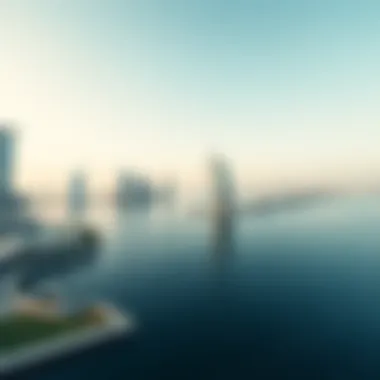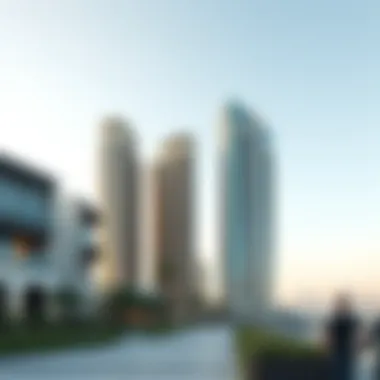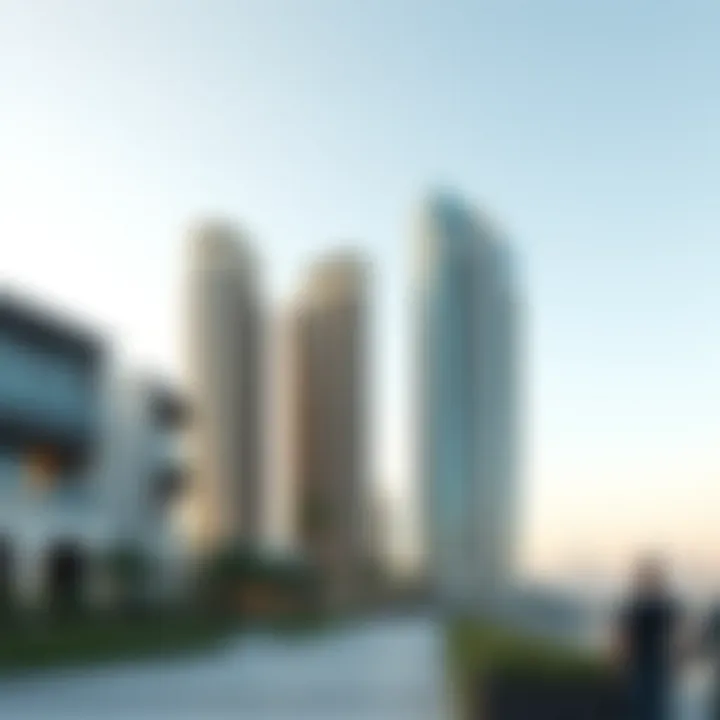Abu Dhabi's Waterfront Development in Real Estate


Intro
Abu Dhabi’s waterfront developments are not just a sight for sore eyes; they form an integral part of the broader real estate landscape in the region. These developments, from lush parks and vibrant entertainment hubs to luxury residences, have been springing up like daisies. They are reshaping the city’s identity while attracting potential investors and homebuyers alike. Understanding the nuances of these projects can provide valuable insights into the current and future real estate dynamics.
As we delve into this topic, we will explore several key aspects. Firstly, we will examine the current market trends specific to Abu Dhabi's waterfront projects, shedding light on what is hot right now. Following that, an analysis of investment opportunities will be conducted, dissecting the areas primed for growth and examining rental yields that can align with investor goals. This article serves as a compass for not only seasoned investors but also budding homebuyers and real estate agents eager to explore this exhilarating market.
In a city that has transformed at breakneck speed, staying updated with the latest developments is crucial. All eyes are on Abu Dhabi, as it continues to carve out a niche in the lucrative domain of waterfront-based real estate.
Thus, let’s lay the groundwork by assessing the market trends affecting these waterfront projects.
Prologue to Abu Dhabi's Waterfront
Abu Dhabi's waterfront area is an increasingly significant focal point in the emirate's urban and economic development strategy. This region is not just about enticing views of the Arabian Gulf; rather, it encapsulates a larger vision that merges luxury living, commercial vitality, and cultural enrichment. As such, it constitutes a vital area of interest for a variety of stakeholders—investors, homebuyers, real estate agents, and industry analysts alike.
Taking a closer look at this topic, we can appreciate several vital aspects that make the waterfront developments particularly noteworthy. First and foremost, the waterfront serves as a catalyst for economic growth. With numerous projects underway, it has the potential to attract both local and international investors, thereby fostering a more diversified economy. Development of high-end residential and commercial spaces not only enhances the region's real estate landscape but also instigates job creation and boosts tourism.
Furthermore, these developments often include public parks, beaches, and retail space, enhancing quality of life and making the waterfront area a desirable place to live and work. For instance, schemes like the Yas Island development are complemented by entertainment options, retail outlets, and recreational spaces—transforming the perception of urban living.
Additionally, the waterfront embodies sustainable architectural trends, with many new projects aiming to minimize their environmental impact while maximizing aesthetic appeal and functionality. This ties into broader goals of sustainable urban development that many global cities are striving to achieve.
The waterfront doesn’t just represent a place for leisure; it’s a blueprint for how urban centers can be designed to harmonize living, working, and nature.
In this article, we will unpack these dimensions in detail, providing a comprehensive guide that illuminates the significance of Abu Dhabi's waterfront. We will explore various ongoing projects, analyze the investment potential they harbor, and consider their socio-economic impacts, ensuring that stakeholders have a clear grasp of what the region offers and where it is headed. Ultimately, understanding Abu Dhabi's waterfront is essential not only for making informed real estate decisions but also for appreciating the larger transformation occurring in the emirate.
Historical Context of Waterfront Development
Abu Dhabi’s waterfront has undergone a remarkable transformation over the decades, reflecting its rich history and evolving economic landscape. This evolution is crucial in understanding how these developments not only change the physical space but also redefine the city's social and economic dynamics.
Waterfront development in Abu Dhabi serves as a window into the city’s aspirations, ambitions, and challenges. The historical context highlights how past developments have shaped current projects and set a framework for future endeavors. Investors and homebuyers should consider this background seriously, as it provides insights into the continuity and shift of urban planning strategies, especially in a rapidly evolving sector like real estate.
The Evolution of Coastal Areas
The coastal areas of Abu Dhabi provide a compelling narrative of growth, from humble beginnings to a booming hub of real estate activity. Initially, these areas were predominantly utilitarian, serving primarily fishing communities and small trade ports. However, as oil was discovered in the late 1950s, the dynamics of waterfront usage started to shift dramatically. The once-small boats of fishermen gave way to large vessels ferrying goods, and this change stimulated urban expansion.
In the 1970s and 1980s, planning began to take a more structured approach. Infrastructure developments such as the Abu Dhabi Corniche marked the beginning of a new era. Projects started focusing on not just utility but also aesthetics and community engagement, with parks and leisure amenities introduced along the coast. This marked a turning point where the waterfront began to be viewed as more than just a trade route, but as a vital part of lifestyle and tourism.
The 2000s represented a significant pivot in the transformation of coastal areas. With international investment flowing into Abu Dhabi, developers began reimagining the waterfront landscape with luxury residential complexes, marinas, and entertainment venues. Projects like the Al Raha Beach and Yas Island epitomize this new approach, bringing global architectural influences and modern living standards to the forefront.
Key Historical Milestones
Several milestones underscore the historical narrative of Abu Dhabi's waterfront development:
- 1973: The launch of the Abu Dhabi Corniche marked the first attempts at developing a public coastal area designed for leisure.
- 2001: The opening of Yas Island introduced a multimodal approach to waterfront living with entertainment and tourism at its core.
- 2007: The Al Reem Island project began, showcasing a shift toward mixed-use developments that integrate residential, retail, and recreational spaces.
- 2012: The completion of the new waterfront promenade at Al Maryah Island signaled the growing trend of combining luxury living with retail and office spaces.
- 2020: The announcement of recycled water initiatives aimed at sustainable development highlighted a growing awareness of environmental responsibility.
These milestones not only reflect changing societal values over time but also represent pivotal moments that have influenced real estate decisions. Overall, understanding this historical context enables potential investors and stakeholders to better navigate the current market landscape and strategize effectively for the future.
"Each waterfront project tells a story that goes beyond bricks and mortar; it encapsulates community, vision, and heritage that define Abu Dhabi."
For more on Abu Dhabi's dynamic growth, consider exploring resources from Britannica and the UAE Government.
Current Waterfront Projects in Abu Dhabi
The waterfront area of Abu Dhabi is a treasure trove of development activity that unpacks a rich tapestry of opportunities for investors and residents alike. With its seamless blend of luxury, sustainability, and cultural elements, the current waterfront projects are pivotal to the real estate landscape in the region. As the demand for waterfront living continues to rise, understanding these developments is essential for any stakeholder in the real estate market, whether you’re looking to invest, relocate, or understand market trends.
Overview of Major Developments
Right now, Abu Dhabi is buzzing with major projects that are not just reshaping the skyline but are also transforming the way people live, work, and play. The waterfront developments include iconic landmarks such as Al Maryah Island, Saadiyat Island, and Yas Island. These projects boast an array of residential options alongside retail spaces, leisure facilities, and cultural institutions, providing a holistic lifestyle choice for various demographics.
- Al Maryah Island: This is a mixed-use development housing apartments, offices, and the renowned Galleria Mall. It’s been dubbed the capital’s financial district and includes amenities intended to enhance the quality of life for its residents.
- Saadiyat Island: An enclave for art and culture, home to several museums and future expansions that promise further cultural attractions. Families are drawn to this area for the educational institutions and beautiful beaches.
- Yas Island: Known for its thrilling entertainment venues including Ferrari World and Yas Waterworld, this spot exemplifies the fusion of leisure with luxury living. It’s a hotspot for both tourists and residents eager for adventure.
This dynamic array of developments not only amplifies property values but also enriches the community experience by providing well-rounded amenities and services.
Key Players in Waterfront Development
The players in Abu Dhabi's waterfront development scene are a mix of local and international entities, each bringing their unique strengths to the table. Some notable names include:
- Aldar Properties: A key player in developing high-quality residential and commercial properties, including several projects on Yas Island.
- Emaar Properties: Known for luxury developments, Emaar has contributed significantly to the waterfront area through its landmark projects in Abu Dhabi.
- ADNOC: The Abu Dhabi National Oil Company has also initiated some projects that intertwine with the waterfront, creating energy-efficient spaces adjacent to this vibrant segment of the city.


These developers play a crucial role, shaping not only the physical landscape but also fostering economic growth by creating employment opportunities and enhancing the overall appeal of the region. Their investments underline the trust in Abu Dhabi's long-term economic prospects, suggesting a stable path forward for potential investors.
"The future of waterfront properties in Abu Dhabi reflects a commitment to community, culture, and sustainable living, attracting diverse groups who wish to be part of this vibrant ecosystem."
By actively engaging with current projects, investors can leverage their insights to make informed decisions that align with broader trends in the marketplace. The ongoing developments signify more than just buildings; they represent a vision for the future that blends luxury with functionality in a growing urban landscape.
Investment Opportunities in Waterfront Properties
Investing in waterfront properties in Abu Dhabi is not just about acquiring a piece of real estate; it's about becoming part of a growing narrative where the water meets opportunity. The allure of waterfront living draws both local and international interest, making it a pivotal area for real estate investment. As urban landscapes evolve, the demand for properties that offer both scenic views and modern amenities continues to escalate.
Analyzing the Market Value
When it comes to determining market value for these waterfront properties, several layers come into play. First off, location is key. Properties situated in prime neighborhoods, such as the stunning Al Reem Island or the affluent Saadiyat Island, command higher prices due to their proximity to natural beauty, cultural hubs, and essential services.
In addition to location, the type of development also influences market value. Whether one is looking at luxury apartments with high-end finishes or family-friendly villas, each caters to various demographics. Recent data have shown a marked increase in property values in these regions, largely driven by an influx of buyers seeking both investment returns and lifestyle enhancements.
Market accessibility also matters. Amidst the ongoing developments, the addition of new transport routes and commercial facilities boosts attractiveness, bolstering property desirability and enhancing value. Buyers are often willing to pay a premium for properties linked to good connectivity.
Furthermore, local policies and regulations around waterfront developments can impact market values. Investors must stay updated on governmental initiatives that support coastal real estate, as these can either facilitate growth or pose hindrances, depending on how they are structured.
Factors Influencing Investment Returns
Investment in waterfront properties holds promise, but it comes with its own set of considerations that affect potential returns. Here are some key factors to keep in mind:
- Economic Climate: A booming economy generally bodes well for real estate values, while downturns can hinder growth. Current conditions in the UAE are favorable for real estate due to strong economic pillars.
- Tourism Appeal: Abu Dhabi is becoming a global tourist hotspot. Properties that cater to tourist needs, such as rental apartments near attractions, often enjoy higher returns due to consistent demand.
- Supply and Demand: Real estate markets thrive on the balance of supply and demand. Increased construction of new properties without a matching demand could lead to oversaturation. Investors must analyze trends to ensure a sustainable market moving forward.
- Quality of Life: Properties that offer access to parks, entertainment venues, and leisure activities enjoy higher attraction rates. Features like private beaches or proximity to cultural events can significantly uplift property value.
In essence, waterfront properties are a window to lucrative opportunities, but require keen analysis to navigate the complexities of the market.
Investors who keep their finger on the pulse of these factors are more likely to secure successful investments and see fruitful returns in Abu Dhabi's vibrant waterfront landscape.
Lifestyle and Amenities on the Waterfront
Abu Dhabi's waterfront developments represent more than just architectural marvels; they embody a lifestyle choice that attracts residents and investors alike. The waterfront is a tapestry woven with leisure, culture, and convenience, providing an enviable setting for both living and working. Accessibility to water activities, scenic views, and the vibrancy of community life are key elements that make these developments particularly appealing.
The selection of lifestyle amenities along the waterfront is essential for enhancing the overall quality of life for those who call these places home. Residents enjoy a plethora of recreational options, from yacht clubs to beachfront parks that encourage a healthy and active lifestyle. Cafés, restaurants, and market squares scattered throughout various developments enrich the social fabric, inviting gatherings and fostering a sense of community.
Residential Options Available
In the heart of waterfront projects, the residential options are as diverse as the people who inhabit them. High-rise condominiums with sweeping views of the Arabian Gulf stand shoulder to shoulder with luxury apartments, each catering to different tastes and budgets. The allure of living by the water is complemented by residential designs that focus on comfort and modernity.
Moreover, some projects feature villas that exude exclusivity and elegance. The properties often come with private pools and gardens, offering residents a serene escape amidst the urban buzz. The integration of smart home technologies further enhances the living experience, making day-to-day activities seamless and aligned with modern expectations.
Each residential option not only meets aesthetic desires but also practical needs, such as proximity to schools and healthcare facilities. Neighborhood design promotes sustainability, with green spaces creating a pleasant ambiance and encouraging outdoor activities.
Commercial Spaces and Retail Developments
Commercial spaces along the waterfront are unmistakably designed with both utility and aesthetic appeal in mind. Retail outlets and restaurants featuring local and international brands create a dynamic marketplace that stimulates the economy while providing for the residents’ needs.
These venues are not merely places to shop or dine; they are vibrant social hubs that contribute significantly to the waterfront’s cultural pulse.
The successful blend of leisure and commerce means that residents can spend more time enjoying their surroundings rather than commuting long distances for daily necessities.
From shopping centers boasting the latest fashion trends to artisanal markets that celebrate local craftsmanship, the variety available is staggering. Businesses benefit from high foot traffic and tourism, resulting in an environment ripe for economic growth.
Furthermore, the design of commercial spaces often mirrors the luxurious feel of residential environments, creating a cohesive experience across the waterfront. Architects and planners focus on walkability, ensuring that lush pathways connect shops, parks, and dining areas, thus enhancing the attractiveness of the area for both locals and tourists.
Ultimately, the blend of residential and commercial options on Abu Dhabi's waterfront is a testament to thoughtful urban planning, facilitating a rich and engaging lifestyle. Investors and homebuyers can expect more than just property; they are tapping into a lifestyle enriched with convenience, community, and cultural vibrancy.
For further information, resources like Wikipedia or Britannica offer great insights into urban developments.
Stay updated with real estate opportunities through forums or community boards like Reddit.
Regardless of whether one is looking to invest or settle down, the vibrant lifestyle and amenity-rich offerings make Abu Dhabi's waterfront an attractive proposition.
Environmental Considerations in Waterfront Development
As waterfront developments continue to evolve, it's paramount to prioritize environmental considerations. These aspects not only shape the physical landscape but also reflect on the economy and the quality of life for current and future residents. Smart, sustainable practices in construction and design contribute to the preservation of Abu Dhabi's natural beauty while catering to the demands of a growing population.
A focus on environmental considerations allows developers to enhance biodiversity, reduce waste, and lower carbon emissions, making these projects more appealing for stakeholders. Moreover, engaged communities are increasingly interested in the ecological impact of real estate investments. Investors and homebuyers alike value projects that offer sustainability, which ties into long-term viability.


Sustainability Initiatives
The implementation of sustainability initiatives in waterfront development is about marrying ambition with responsibility. In Abu Dhabi's rapidly changing real estate scene, these initiatives emerge as central themes, signaling a move towards a greener future. Various developments incorporate energy-efficient systems and renewable energy sources, such as solar panels and wind turbines. This not only reduces operational costs but also attracts forward-thinking investors who align with environmental stewardship.
Recent advancements in green building standards play a critical role in ensuring construction processes minimize harm to nature. For instance, initiatives such as Estidama, which promotes sustainable building practices, are applied to many waterfront projects. This approach evaluates a structure’s environmental performance and provides guidelines that meet the unique coastal climate.
Investment in water recycling systems, the use of local materials to decrease transport emissions, and landscaping that supports local flora contribute to a reduced environmental footprint. From the perspective of savvy investors, these sustainability initiatives are monetarily and ethically sound, driving value upwards.
Impact on Marine Ecosystems
With waterfront developments, the balance between enhancing urban spaces and maintaining marine ecosystems is delicate. The coastal areas of Abu Dhabi house diverse marine life that can be easily disrupted by construction activities. Developers must take into account the health of marine ecosystems when planning new projects.
Increased urbanization puts pressure on existing habitats, so protecting wetlands and coral reefs becomes vital. Mitigation strategies form an essential component of development planning. Whether creating artificial reefs or preserving critical habitats, developers are becoming more aware of their responsibility toward marine life.
Collaboration with environmental organizations is also gaining traction; developers often engage scientists to monitor and evaluate marine ecosystems before and after project completion. This monitoring ensures that the actions taken do not inadvertently degrade valuable marine environments.
“The careful consideration of marine ecosystems in development plans not only protects biodiversity but enhances the aesthetic and recreational value of waterfront properties, ultimately benefitting the community.”
By placing focus on the preservation of marine life, developers can enhance the appeal of their properties while gaining approval from local and global environmental bodies. Furthermore, with increasing awareness among homebuyers regarding environmental impacts, this creates additional value for properties that emphasize sustainability and ecological balance.
Nevertheless, looking ahead, the integration of strong environmental policies is crucial for the longevity of both the waterfront developments and their surrounding ecosystems. As Abu Dhabi's waterfront continues to attract investment and growth, prioritizing these environmental considerations will be key to fostering a harmonious relationship between urban development and nature.
Architectural Trends in Waterfront Projects
The architectural landscape of Abu Dhabi's waterfront developments is not just about aesthetics but a reflection of innovative thinking and sustainability. This section unpacks the significance of these trends within the broader context of the city’s real estate ambitions. It underscores how design philosophies are evolving in response to both environmental needs and community desires.
Creating a visually appealing ambiance is only part of the story. The architecture must align with strategic economic goals and social needs, bringing forth developments that meet modern demands while honoring tradition. Key elements of these architectural trends include:
- Sustainable Design: With pressure to diminish environmental footprints, architects are prioritizing energy-efficient materials and systems. Designs now often incorporate solar panels, green roofs, and water recycling systems.
- Blending Functions: The latest projects don’t merely cater to residential needs. They fuse living spaces with commercial units, green parks, and recreational facilities, cultivating a lively community atmosphere.
- Cultural Sensitivity: Architectural styles increasingly reflect the cultural identity of Abu Dhabi. Designs pay homage to local heritage while incorporating contemporary features, creating a dialogue between past and present.
These architectural trends are reshaping waterfront real estate in Abu Dhabi, making them not just places to live and work but experiences that enrich life.
Innovative Design Approaches
When looking at innovative design approaches in waterfront architecture, it is easy to spot a marked shift toward creativity driven by both technology and necessity. Cutting-edge tools like Building Information Modeling (BIM) are revolutionizing how architects design and execute projects.
New materials are also coming onto the scene, while 3D printing technology enables the creation of intricate structures that were previously unimaginable. This tech-driven evolution has encouraged architects to think outside the box, to consider not just the structural integrity, but also how buildings can interact more harmoniously with nature and community.
Examples of Innovative Designs include:
- Curvilinear Shapes: Designs that mimic natural forms, enhancing the flow of spaces.
- Modular Construction: Techniques that allow for faster and more efficient building processes, adapting easily to changes in demand.
These approaches raise the bar for creativity and adaptability in waterfront design—making it clear that the future of architecture in Abu Dhabi, particularly along its coastlines, is bright and filled with possibilities.
Integration with the Surrounding Landscape
A critical aspect of contemporary waterfront projects in Abu Dhabi is their integration into the surrounding landscape. This isn't simply about placing buildings next to the water but creating a cohesive environment where structures complement their natural and urban settings.
Architects are increasingly tasked with ensuring that properties enhance the local ecosystem rather than disrupt it. A key focus lies in preserving natural habitats and promoting biodiversity. For instance, projects now often feature native vegetation, minimizing the need for extensive irrigation systems and fostering local wildlife.
Moreover, there's a push toward creating public spaces, walkways, and parks that connect communities with water features. This encourages recreational activities and promotes well-being amongst residents and visitors alike.
Key considerations for integration include:
- Site Analysis: Understanding existing natural elements like tides, winds, and vegetation.
- Community Feedback: Involving local communities in the planning process to better align projects with their needs and preferences.
- Cultural Narratives: Crafting designs that tell the story of the area's heritage, thereby fostering a sense of place and identity.
This emphasis on landscape integration positions Abu Dhabi's waterfront not only as residential and commercial hubs but as vital connective tissue within the fabric of the city itself.
The Socioeconomic Impact of Waterfront Developments
The socioeconomic impact of waterfront developments in Abu Dhabi is substantial, permeating various facets of life in the emirate. This section examines the multifaceted effects that such developments have on the economy and community at large. The revival and growth of waterfront areas not only energize the real estate market but also foster a sense of belonging among residents and visitors. Through job creation, enhancement of local connectivity, and an overall boost to quality of life, these projects emerge as cornerstones of the city’s advancement.
Job Creation and Economic Growth
One cannot underestimate the role of waterfront projects in generating employment opportunities. Major initiatives like Saadiyat Island and Yas Island hub an array of services and commercial ventures, which spur job creation across sectors.
- Direct Jobs: The construction of residential towers, retail spaces, and leisure facilities requires a vast labor force during development phases. Once completed, these structures demand personnel from maintenance to management staff, which translates into sustained job opportunities.
- Indirect Employment: Beyond direct employment, there’s a ripple effect in local businesses. Cafés, restaurants, retail shops, and entertainment venues spring up, each requiring staff. This cycle invigorates various supply chains that benefit indirectly from the waterfront's presence.
- Investment Influx: The waterfront area often becomes a magnet for local and international investors. Increased interest leads to vast infusions of capital into not just real estate, but also tourism and recreational sectors, further circulating economic activity.
"A thriving waterfront not only beautifies a city but also injects life into its economy, transforming mere landscapes into bustling hubs of opportunity."


Moreover, the maritime developments encourage tourism, drawing visitors who contribute to local shops and hotels, thus ensuring a continuous cycle of economic stimulation.
Enhancing Community Connectivity
Waterfront developments don’t only provide physical structures; they also forge vital connections within the community. Connectivity is more than just transportation; it encompasses the ways people interact and engage with their surroundings. Key aspects include:
- Public Spaces: Well-designed waterfront areas feature parks, piers, and walkways that encourage social interaction. Places like the Corniche offer residents and tourists alike opportunities to connect, fostering a sense of community pride.
- Transportation Links: These projects often incorporate improved infrastructure—roadways, public transit options, and pedestrian pathways—that enhance accessibility. This interconnectivity makes it easier for residents to traverse the community and access essential services.
- Cultural Integration: Waterfront developments often celebrate local culture through art installations and promotional events. They serve as venues where diverse groups come together, enabling cultural exchange and boosting local identity.
In summary, the socioeconomic impact of waterfront developments in Abu Dhabi is significant and wide-reaching. From creating jobs to enhancing community relations, these projects are not merely about property; they are about shaping the way people live, work, and interact with one another and their environment. As Abu Dhabi continues to develop its coastline, the implications for economic vitality and community cohesiveness will remain paramount.
Challenges Facing Waterfront Developments
Waterfront developments in Abu Dhabi serve as a beacon of progress and innovation, but they also come with their fair share of challenges. Understanding these issues is crucial for investors, homebuyers, and real estate professionals alike. The success of such projects relies not only on their aesthetic appeal and economic promise but also on the way these challenges are navigated.
Regulatory Hurdles
One of the most significant barriers that waterfront developments face is regulatory hurdles. These include complex zoning laws, environmental regulations, and the intricate approval processes required by various governmental bodies. In many cases, rules can differ greatly between localities, adding layers of complexity to developers’ plans. For instance, a project that seems promising in one area might encounter stricter regulations in another, often leaving developers scrambling to meet compliance.
Moreover, the growing emphasis on sustainability means that developers must adhere to stringent environmental guidelines, which can impact timelines and budgets. As an example, the need for environmental impact assessments can delay projects for months, if not years.
In addition, community opposition can serve as another regulatory hurdle. Local residents may have concerns about how new development will affect their lifestyle, and public consultations can quickly escalate if these worries aren’t adequately addressed. As a result, taking the time to engage with the community and stakeholders early in the project cycle can make a substantial difference.
Economic Pressures and Market Volatility
Alongside regulatory challenges, economic pressures and market volatility pose substantial risks for waterfront projects. The fluctuations in global oil prices can impact investor confidence, shaping a rather unpredictable landscape. Investors must be wary of potential downturns in the economy, which could lead to decreased demand for residential and commercial properties. This volatility can create a situation where projects initiated during optimistic times might stall or even halt altogether when economic conditions shift.
The costs associated with waterfront developments can also be exorbitant, emphasizing the need for sound financial planning. Labor and materials costs can rise surprisingly high, especially in such a competitive market where many developers vie for the same resources. To mitigate these risks, developers often turn to a diversified investment strategy, ensuring that their revenue streams are not solely dependent on the success of one project.
In summary, addressing the challenges of regulatory hurdles and economic pressures is imperative for successful waterfront development in Abu Dhabi. Navigating these complex issues requires a keen understanding of not only the local market but also the broader economic landscape. A commitment to transparency and community engagement can facilitate smoother transitions through these troubled waters. Ultimately, embracing these challenges can lead to more resilient and thriving waterfront developments that benefit the region as a whole.
Future Trends in Abu Dhabi's Waterfront Development
As Abu Dhabi continues to establish itself as a vibrant urban hub, waterfront development stands at the forefront of its planning strategies. This section delves into the future trends shaping this landscape, focusing on emerging technologies, sustainability initiatives, and smart city concepts that will redefine the region’s waterfront. Understanding these trends is crucial for investors, homebuyers, and real estate professionals seeking to navigate the evolving market.
Emerging Technologies and Their Impact
The integration of cutting-edge technology is transforming the way waterfront developments are approached in Abu Dhabi. From smart building systems to innovative construction methodologies, these advancements enhance the appeal and functionality of properties. For instance, blockchain technology is being leveraged to streamline property transactions, making buying and selling waterfront real estate quicker and more transparent.
Another significant technological trend is the use of augmented reality (AR) in property showcases. Prospective buyers can visualize the properties and their surroundings through interactive AR applications. This not only personalizes the property viewing experience but also helps buyers make informed decisions without the need to be physically present.
Moreover, facilities powered by renewable energy solutions are becoming increasingly popular. Solar panels, for example, are frequently integrated into the architectural design of new developments, aligning with global sustainability goals while offering cost-saving benefits for residents.
The Role of Smart Cities
Smart city frameworks are set to play an influential role in the future of Abu Dhabi's waterfront. These urban environments are characterized by the use of intelligent technologies to improve the quality of life for their citizens. One key aspect is enhanced connectivity.
Through advanced transportation networks, including electric public transport options and intelligent traffic management systems, waterfront developments are becoming more accessible. This supports greater community interaction and a bustling economic landscape.
Furthermore, data-driven urban planning enables the government to monitor and analyze the needs of residents efficiently. This approach aids in making responsive adjustments in real time, ensuring that the growth of waterfront areas is both sustainable and aligned with the community’s lifestyle preferences.
In addition, waterfront communities are more likely to incorporate green spaces, promenades, and recreational areas, enhancing overall livability. The design of these spaces often reflects the local culture while providing residents and visitors with a sense of connection to the natural environment.
"Sustainable waterfronts signify more than just development; they mark the evolution of urban living and the commitment to preserving our natural heritage."
Overall, these future trends within Abu Dhabi's waterfront development signify not only a shift in real estate dynamics but also an evolution in lifestyle—ultimately making the city a more attractive destination for investment and living alike.
Closure: The Way Forward
In reflecting on Abu Dhabi's waterfront development, the path ahead holds profound importance for a multitude of stakeholders in the real estate sector. The challenges faced and the opportunities presented underscore the dynamic nature of this market. Both investors and homebuyers must be aware of the transformative shifts occurring along the coastline of this emirate.
The incorporation of sustainability measures links directly to enhanced desirability for both residential and commercial properties. For local businesses, integrating eco-friendly practices can mean not just compliance with regulations, but a means to attract environmentally conscious consumers. Moreover, as Abu Dhabi positions itself as a global hub, the strategic development of waterfront areas signifies a commitment to modernity and innovation.
"The waterfront is not merely a place; it's an experience that defines the character of a city."
Summarizing Key Insights
Recent trends in Abu Dhabi's waterfront areas show a rising interest in mixed-use developments that blend residential, commercial, and leisure spaces. This multifaceted approach enriches the community experience, which attracts diverse demographics, including expatriates looking for appealing living options and tourists seeking vibrant atmospheres. The waterfront real estate landscape is shifting towards more integrated and inclusive designs.
- Diversified Investments: The shift towards mixed-use developments opens avenues for varied investments, appealing to family setups and solo professionals alike.
- Enhanced Amenities: Waterfront developments now include parks, recreational facilities, and retail areas that enhance lifestyle choices.
- Community Orientation: The focus on community connectivity serves to strengthen social bonds in an increasingly globalized world.
Looking Ahead at Development Prospects
Looking forward, the potential for Abu Dhabi's waterfront development remains bright. As technological advancements continue to reshape the urban environment, one can expect even more innovative designs and approaches. Projects utilizing smart technologies not only enhance efficiency but also improve the quality of life for residents.
- Emerging Technologies: Innovations like IoT in management systems can lead to smarter, energy-efficient living spaces.
- Smart Cities: The role of intelligent urban planning is more crucial than ever, aiming for sustainability while ensuring convenience.
- Visitor Attraction: Continued investment in tourism infrastructure around waterfront areas is likely to bolster economic gains, showcasing Abu Dhabi as a premier destination.











